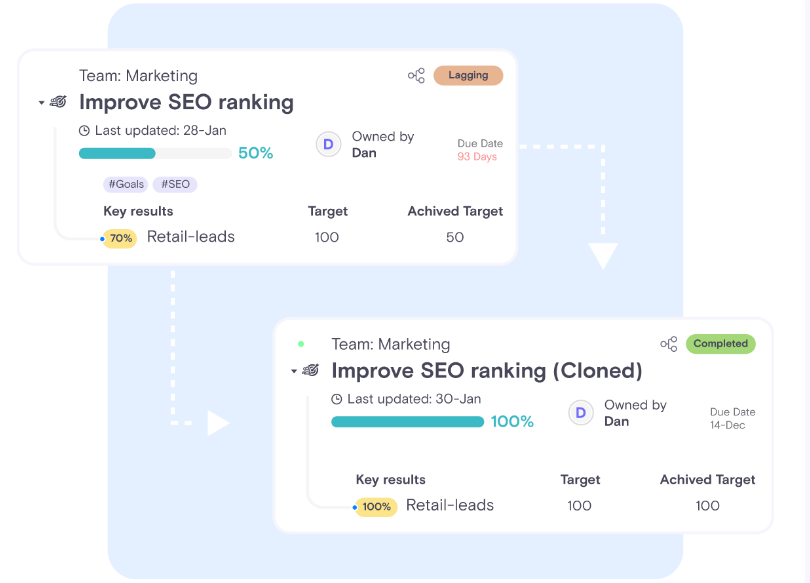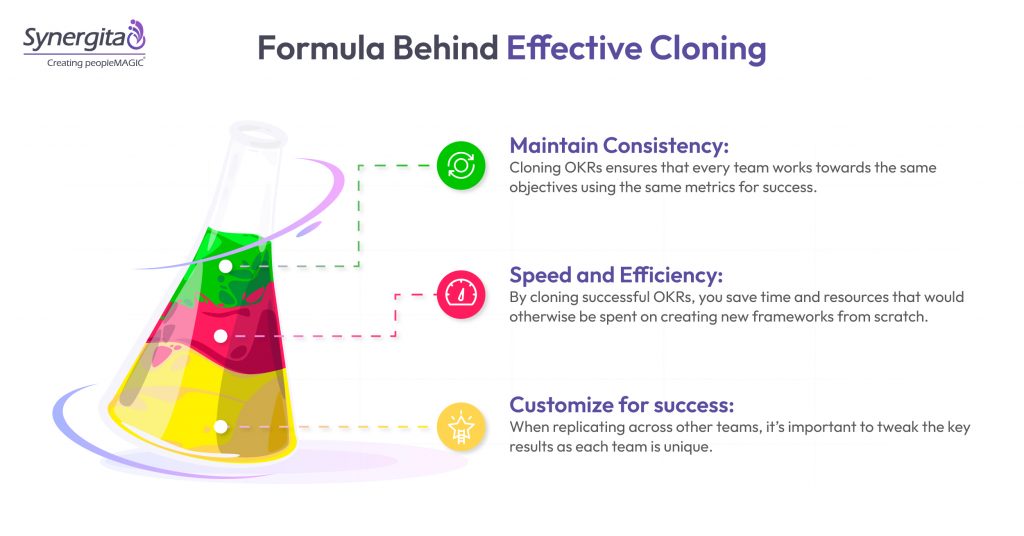In the business world, when a formula works, there is a natural desire to replicate it across the organization. However, reproducing the same results consistently requires a systematic approach. The objectives and key results (OKR) framework, which focuses on achieving goals through measurable key results, helps businesses maintain agility. Scaling an organization is like cloning a successful recipe for a larger crowd, where the main objectives and how to achieve them (key results) must be replicated accurately to ensure the same superior outcome. For HR leaders and CEOs, the challenge is to scale this success across the organization without losing the essence of what made the pilot successful. Cloning is a method to replicate OKRs that have led to successful outcomes, while maintaining alignment and focus.
What is OKR Cloning?
OKR Cloning allows you to take a proven set of goals and seamlessly extend them across the company, teams, and individuals, ensuring everyone is aligned and moving in the same direction. This functionality is designed to streamline OKR management by utilizing the framework of previously successful objectives, thereby saving time and ensuring consistency. It is particularly beneficial when you need to continue to work across quarters. For example, if you’ve made partial progress in one quarter, Cloning allows you to carry over the objectives and start afresh so you can track progress in the new time frame.

Consider a tech company that achieved significant sales growth using a specific set of OKRs for their sales team. Cloning OKRs allows the company to streamline its sales processes, ensure consistency in execution, and accelerate its overall revenue generation. This approach ensures that successful sales strategies become repeatable, driving continuous improvement and growth across the sales organization.

Best Practices for OKR Cloning
While there can be different reasons for Cloning. It is important to document the successful OKRs and analyze what made them effective. Look into the specific objectives set, the key results used to measure success, and any unique strategies or approaches employed. Here are some steps that you can take to replicate successful OKRs:
- Identify Proven OKRs: Start with the objectives and key results that have delivered tangible success.
- Customize for Context: While the core OKRs remain the same, allow for customization to fit the specific context of different teams.
- Monitor and Adapt: Continuously monitor the performance of Cloned OKRs. Be ready to course correct based on feedback.
When to Clone OKRs?
The Synergita OKR software provides users ample customization options and considers the different situations in which you may want to Clone OKRs.
So, let’s dive in when to clone:
- Continuing Work Across Quarters: Carry over unfinished OKRs that you can tweak and track.
- Setting Up New Objectives: Align cross-functional teams by replicating existing OKRs. You can customize objectives without starting from scratch.
While Cloning, you can reset progress for the new period. This ensures clarity, allowing teams to build on past achievements and drive future success efficiently. You can choose to Clone with or without key results. If you Clone with key results, you can add up to 10 users as owners, each receiving a separate Cloned objective.
Here’s a guide to Cloning with Synergita OKR.
Where it can go wrong
Leaders often mistakenly impose their vision with authoritarian rigidity, believing that culture should be dictated from the top. Instead, successful leaders recognize the importance of Cloning effective OKRs to maintain consistency while allowing for flexibility. This approach ensures that proven objectives and key results are replicated across teams, providing a solid foundation for alignment and growth.
No two teams have identical cultures, and what works for one may not work for another. Conventional metrics like productivity and cost reduction don’t align with outcome-focused approaches, which value customer satisfaction, and team happiness. Modern methodologies emphasize delivering small increments of value, learning from failures, and celebrating successes that may not be quantifiable by traditional standards.
A value-driven approach shifts the focus from cost efficiency to meaningful work that encourages innovation and better serves customers. Leaders must understand that scaling introduces new complexities and interdependencies. As these methods grow, they may mirror the structural challenges of the organization, requiring ongoing adaptation and a focus on nurturing each team’s unique strengths and contributions.
Conclusion
OKR Cloning is a strategic approach to scaling your organization efficiently and effectively. By replicating success, maintaining consistency, and fostering a culture of continuous improvement, you can navigate the complexities of growth with confidence and precision. A feature that is especially useful for larger teams during OKR implementation, you can try it for free during the 7-day trial when you sign up. So why wait? experience the ease of goal setting with Synergita OKR.

